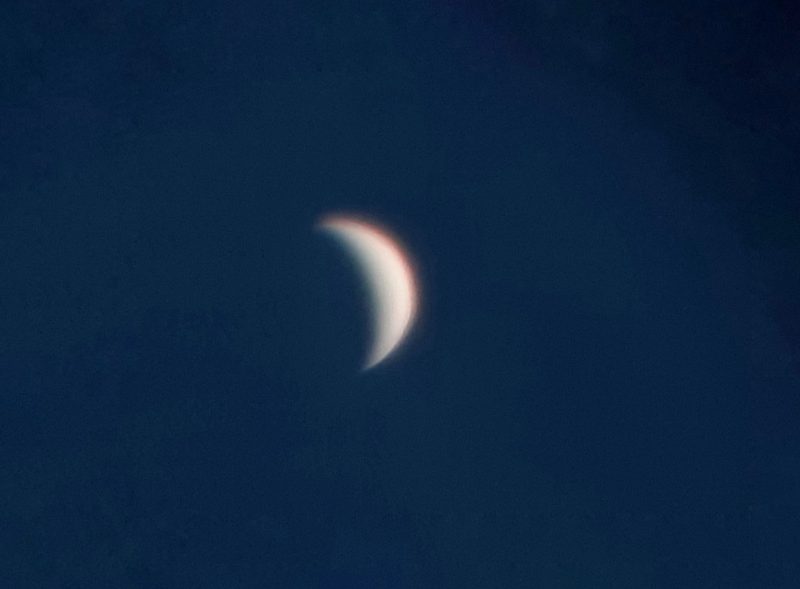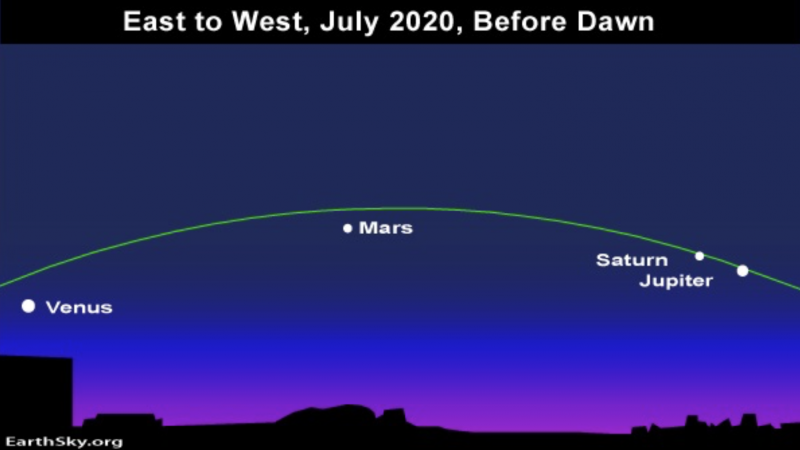
Before daybreak on July 16, 17, 18 and 19, 2020, look east! You’ll see the two brightest objects of nighttime, the moon and the planet Venus, near each other. These two bright worlds will be hard to miss. Some people who are looking carefully might even continue to see them after sunrise. There’s another planet shown on the chart above: Mercury. It’s harder to find. You’ll find more about finding Mercury below.
Watch for the soft glow of earthshine illuminating the dark or night portion of the moon. Earthshine is twice-reflected sunlight. From the moon right now, Earth appears as a large gibbous sphere (more than half lighted but less than full). It’s big and bright in the lunar sky. Just as moonlight illuminates our earthly landscape when our moon is large and nearly full, so this nearly full Earth illuminates the lunar landscape. It’s this light that causes the glow of earthshine, visible whenever the moon is a crescent.
If you have a telescope, you know that Venus is in a crescent phase now, too. We’d love to see your photos. You can submit a photo to EarthSky here.

View at EarthSky Community Photos. | Recent photo of crescent Venus, 27.8% illuminated. Aurelian Neacsu in Visina, Dambovita, Romania, captured this image on July 11, 2020. Venus passed between us and the sun on June 3. It’s now a waxing crescent, visible in the east before sunup. You need a telescope to see the crescent shape, but strong binoculars might show you that Venus is something other than perfectly round. Thank you, Aurelian!
Jupiter, Saturn, Mars. In addition to Venus, there are three other bright planets easy to see before sunup now. The second brightest planet – Jupiter – is out from dusk until dawn, and thus it sits low in the western half of the sky before daybreak. Saturn is that bright golden object near Jupiter, just a short hop away all night long. Mars is much higher up, roughly midway between Venus and Jupiter.
Click here to know the moon’s position on the zodiac via Heavens-Above

Four brilliant planets light up the July morning sky. Venus, the brightest, shines in the east before sunup. Jupiter, 2nd-brightest, shines in the western half of your sky. Look for Saturn close to Jupiter. Look for Mars roughly midway between Venus and Jupiter. If you search hard – and have good sky conditions near your eastern horizon at dawn – you might catch a 5th planet, Mercury, below Venus, near the coming sunrise.
Mercury. And there’s a fifth planet in the early morning sky. Far and away, Mercury – the solar system’s innermost planet – poses the biggest challenge of these morning planets. You might need binoculars to spot it in the glow of dawn. But if you’re game, the lit side of the lunar crescent serves as your arrow in the sky these next few mornings, pointing to Mercury’s approximate rising spot on the horizon. On July 19, the old whisker-thin lunar crescent will pass to the north of Mercury.
For almost any place worldwide, find out when Mercury climbs into your sky via TimeandDate.com
Read more: Mercury in the July morning sky
Bottom line: On the mornings of July 16, 17, 18 and 19, 2020, enjoy the beautiful presence of the waning crescent moon near Venus, the brightest planet. Look for them in the east, the sunrise direction.
from EarthSky https://ift.tt/3h0dp6Z

Before daybreak on July 16, 17, 18 and 19, 2020, look east! You’ll see the two brightest objects of nighttime, the moon and the planet Venus, near each other. These two bright worlds will be hard to miss. Some people who are looking carefully might even continue to see them after sunrise. There’s another planet shown on the chart above: Mercury. It’s harder to find. You’ll find more about finding Mercury below.
Watch for the soft glow of earthshine illuminating the dark or night portion of the moon. Earthshine is twice-reflected sunlight. From the moon right now, Earth appears as a large gibbous sphere (more than half lighted but less than full). It’s big and bright in the lunar sky. Just as moonlight illuminates our earthly landscape when our moon is large and nearly full, so this nearly full Earth illuminates the lunar landscape. It’s this light that causes the glow of earthshine, visible whenever the moon is a crescent.
If you have a telescope, you know that Venus is in a crescent phase now, too. We’d love to see your photos. You can submit a photo to EarthSky here.

View at EarthSky Community Photos. | Recent photo of crescent Venus, 27.8% illuminated. Aurelian Neacsu in Visina, Dambovita, Romania, captured this image on July 11, 2020. Venus passed between us and the sun on June 3. It’s now a waxing crescent, visible in the east before sunup. You need a telescope to see the crescent shape, but strong binoculars might show you that Venus is something other than perfectly round. Thank you, Aurelian!
Jupiter, Saturn, Mars. In addition to Venus, there are three other bright planets easy to see before sunup now. The second brightest planet – Jupiter – is out from dusk until dawn, and thus it sits low in the western half of the sky before daybreak. Saturn is that bright golden object near Jupiter, just a short hop away all night long. Mars is much higher up, roughly midway between Venus and Jupiter.
Click here to know the moon’s position on the zodiac via Heavens-Above

Four brilliant planets light up the July morning sky. Venus, the brightest, shines in the east before sunup. Jupiter, 2nd-brightest, shines in the western half of your sky. Look for Saturn close to Jupiter. Look for Mars roughly midway between Venus and Jupiter. If you search hard – and have good sky conditions near your eastern horizon at dawn – you might catch a 5th planet, Mercury, below Venus, near the coming sunrise.
Mercury. And there’s a fifth planet in the early morning sky. Far and away, Mercury – the solar system’s innermost planet – poses the biggest challenge of these morning planets. You might need binoculars to spot it in the glow of dawn. But if you’re game, the lit side of the lunar crescent serves as your arrow in the sky these next few mornings, pointing to Mercury’s approximate rising spot on the horizon. On July 19, the old whisker-thin lunar crescent will pass to the north of Mercury.
For almost any place worldwide, find out when Mercury climbs into your sky via TimeandDate.com
Read more: Mercury in the July morning sky
Bottom line: On the mornings of July 16, 17, 18 and 19, 2020, enjoy the beautiful presence of the waning crescent moon near Venus, the brightest planet. Look for them in the east, the sunrise direction.
from EarthSky https://ift.tt/3h0dp6Z

Aucun commentaire:
Enregistrer un commentaire